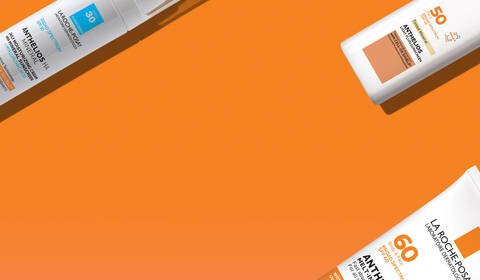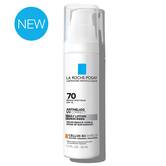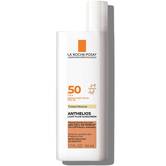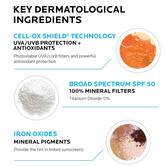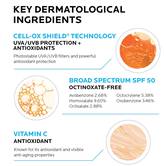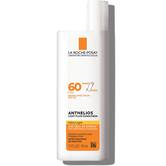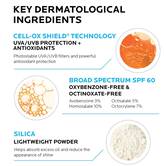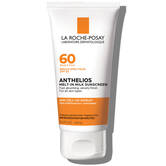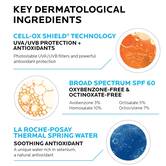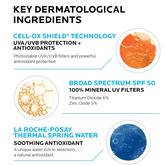What is Cell-Ox Shield® technology?
Cell-Ox Shield ® Technology is La Roche-Posay’s combination of Broad Spectrum UVA/UVB filters and powerful antioxidant protection, found in Anthelios Sunscreen formulas:
Broad Spectrum UVA/UVB filters: Combines photostable UVA/UVB filters chosen for their synergistic effect to deliver broad spectrum protection. Available in daily protection formulas, as well as water resistant formulas up to 80 minutes.
Powerful Antioxidant Protection: with Senna Alata, a tropical leaf extract known to help neutralize damaging free radicals that can accelerate skin aging.
Does La Roche-Posay have “reef safe” and oxybenzone free sunscreens?
Since the term ‘Reef Safe’ is a non-regulated claim and does not have a clear definition by the FDA, La Roche-Posay does not use this term to describe its sunscreen formulations. However, the majority of La Roche-Posay sunscreens are Hawaii Compliant, meaning they are formulated without Oxybenzone & Octinoxate. Hawaii will prohibit the sale and distribution of sunscreens that contain Oxybenzone and Octinoxate starting in 2021.
Since 2016, all new La Roche-Posay Anthelios sunscreens have been formulated without Oxybenzone. Additionally, the rest of Anthelios sunscreens are being reformulated to be Oxybenzone-free sunscreens. La Roche-Posay Anthelios sunscreens do not contain Octinoxate.
Does La Roche-Posay have fragrance free sunscreens?
All La Roche-Posay sunscreens are fragrance free.
Does La Roche-Posay have mineral only sunscreens?
o Yes, La Roche-Posay offers an assortment of 100% mineral UV filter (i.e. physical) formulas with titanium dioxide and zinc oxide that can be found HERE.
Which La Roche-Posay sunscreens include Mexoryl™?
Anthelios SX SPF 15 is the only La Roche-Posay broad spectrum sunscreen that includes Mexoryl™, the only new sun filter approved by the FDA to be used in a sunscreen product in the last 20 years. This filter is an exclusive Ultraviolet A absorber, specifically formulated to help protect against short and long UVA rays which are critical in helping reduce signs of aging caused by the sun.
Does La Roche-Posay have waterproof sunscreen?
La Roche-Posay’s Anthelios offers a variety of formulas, including face and body sunscreens that are water resistant up to 80 minutes. Check the packaging for details.
What should I look for in a sunscreen for sensitive skin?
For sensitive skin, dermatologists often recommended looking for mineral sunscreens that contain either zinc oxide and/or titanium dioxide. All Anthelios sunscreens are tested on sensitive skin. They are all formulated and rigorously tested for optimal skin tolerance.
What’s the difference between a chemical and mineral sunscreen?
There are two main types of sunscreens: Mineral (Physical) and Chemical (Organic). Sunscreens containing mineral ingredients such as zinc oxide and titanium dioxide sit on the top layer of the skin and mainly function by reflecting and scattering UV rays. On the other hand, chemical sunscreens which contain organic compounds such as octocrylene and avobenzone absorb UV rays in the upper layers of skin. Learn more about the differences between mineral and chemical sunscreens HERE
What are the advantages and disadvantages to chemical vs mineral sunscreens?
The advantage of mineral or physical sunscreens containing zinc oxide is that they work as soon as you apply them to the skin, whereas sunscreens containing chemical ingredients often take at least 15 minutes to properly absorb, which means that your skin may not be immediately protected.
A disadvantage of mineral sunscreens is that because they sit directly on the skin, they may rub, sweat or rinse off more easily compared to chemical sunscreens. They can often leave behind a white paste or residue on the skin, which is not cosmetically ideal.
How do I choose an SPF number?
SPF, also known as sun protection factor, measures how much UVB radiation a sunscreen can filter out. Dermatologists recommend an SPF of at least 30, which blocks 97 percent of the sun’s UVB rays. Having a high-number SPF does not necessarily protect you for a longer period of time, but instead offers incrementally more protection from the sun’s UVB rays. According to the AAD, no sunscreen in reality can block 100 percent of the sun’s UVB rays.
Many individuals purchase a higher SPF in hopes that they don’t have to reapply. In reality, a high-number SPF does not mean that you can spend additional time outdoors unprotected. Re-application is essential, especially after being in the water or after a vigorous work-out (sweating). Learn more about how to choose the right SPF for you HERE.
What is the difference between sunblock and sunscreen?
Historically, sunblock has referred to physical or mineral sunscreen filters such as titanium dioxide and zinc oxide. However, the FDA banned sunscreen manufacturers from using the term sunblock in 2013, as it may lead users to overestimate the effectiveness of the product.
How often do you apply sunscreen?
Apply sunscreen at least 15 minutes before you go outside, and don't forget about your ears, the nape of your neck, your feet and ankles, and the backs of your hands. Once you head outside, it’s essential to reapply sun protection every two hours, or more frequently if you're swimming or sweating (even with a water-resistant formula).
How much sunscreen should I apply?
Most people don't use enough sunscreen to get the level of sun protection stated on the bottle—and the proper amount is probably more than you think. The AAD recommends that the average adult needs to apply one ounce (the size of a standard shot glass) to adequately cover their entire body.


